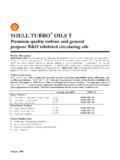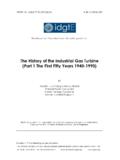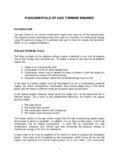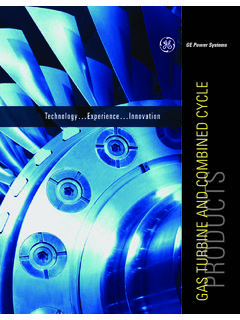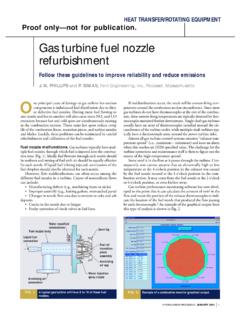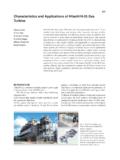Transcription of Standard Guide for Cleaning, Flushing, and …
1 Designation: D 6439 99An American National StandardStandard Guide forCleaning, flushing , and Purification of Steam, Gas, andHydroelectric turbine lubrication systems1 This Standard is issued under the fixed designation D 6439; the number immediately following the designation indicates the year oforiginal adoption or, in the case of revision, the year of last revision. A number in parentheses indicates the year of last reapproval. Asuperscript epsilon (e) indicates an editorial change since the last revision or turbine system reliability requires a well designed lubricating system and use of a goodlubricant that is free of contaminants.
2 Achieving this requires use of proper purification methods toensure that the oil is free of detrimental contaminants. In addition, it requires an ongoing monitoringprogram to ensure that the oil quality is within specifications and that corrective action is taken tominimize contaminant generation and ingression. The benefits of purification of an operatinglubrication system can be significantly reduced if the lubricating systems are not initially cleaned toa level that will prevent component damage on initial start up after manufacturing or and thorough cleaning are required to minimize and remove contaminants during fabrication,rebuilding, or installation, or combination thereof.
3 Because contaminants will remain from theseprocesses, it is necessary to flush and purify the system to remove them prior to startup. Ongoingpurification is required to maintain pure oil during operation. In new systems, the emphasis is on theremoval of contaminants introduced during manufacture, storage, field fabrication, and installation. Inoperational systems, the emphasis is on the removal of contaminants that are generated duringoperation and by malfunctions that occur during operation or contaminants that are introduced duringoverhaul, or To obtain maximum operating reliability and componentlife, it is vital that the turbine lubrication system has pure Guide is intended to aid the equipment manufacturer,installer.
4 And turbine operator in coordinating their efforts toobtain and maintain clean lubrication and control systems may be on land or marine turbine generators andpropulsion and mechanical drive equipment. This Guide isgeneralized due to variations in the type of equipment, build-er s practices, and operating This Guide covers types of contaminants, oil purificationdevices, contamination monitoring, contamination control dur-ing building or refurbishing of turbine systems, lubricationsystem flushing , and maintenance of pure lubrication This Guide primarily addresses petroleum based lubri-cating oil.
5 For systems using nonpetroleum based fluids, thisguide may not be appropriate. For nonpetroleum products,consult the equipment and fluid This Guide is applicable to both large and small lubri-cation systems. Some equipment specified herein, however,may not be appropriate for all systems. Moreover, in situationswhere specific guidelines and procedures are provided by theequipment manufacturer, such procedures should take prece-dence over the recommendations of this Standard does not purport to address the safetyconcerns, if any, associated with its use.
6 It is the responsibilityof the user of this Standard to establish appropriate safety andhealth practices and determine the applicability of regulatorylimitations prior to Referenced standards :D 95 Test Method for Water in Petroleum Products andBituminous Materials by Distillation2D 445 Test Method for Kinematic Viscosity of Transparentand Opaque Liquids (the Calculation of Dynamic Viscos-ity)2D 664 Test Method for Acid Number of Petroleum Productsby Potentiometric Titration2D 974 Test Method for Acid and Base Number by Color-Indicator Titration2D 1533 Test Methods for Water in Insulating Liquids (Karl1 This test method is under the jurisdiction of ASTM Committee D-2 onPetroleum Products and Lubricants and is the direct responsibility of on turbine Oil edition approved Aug.)
7 10, 1999. Published September Book of ASTM standards , Vol ASTM, 100 Barr Harbor Drive, West Conshohocken, PA 19428-2959, United Reaction Method)3D 1744 Test Method for Water in Liquid Petroleum Prod-ucts by Karl Fischer Reagent2D 2272 Test Method for Oxidation Stability of Steam Tur-bine Oils by Rotating Bomb2D 4241 Practice for Design of Gas turbine Generator Lu-bricating Oil Systems4D 4248 Practice for Design of Steam turbine Generator OilSystems4D 4378 Practice for In-Service Monitoring of Mineral Tur-bine Oils for Steam and Gas Turbines4D 4898 Test Method for Insoluble Contamination of Hy-draulic Fluid by Gravimetric Analysis5F
8 311 Practice for Processing Aerospace Liquid Samples forParticulate Contamination Analysis Using Membrane Fil-ters6F 312 Methods for Microscopical Sizing and CountingParticles from Aerospace Fluids on Membrane standards :7 ISO3722 HydraulicFluidPower FluidSampleContainers Qualifying and Controlling cleaning Meth-odsISO 4021 Hydraulic Fluid Power Particulate Contamina-tion Analysis Extraction of Fluid Samples from Lines ofan Operating 4406 Hydraulic Fluid Power Fluids Method forCoding Level of Contamination by Solid ParticlesISO 4572 Hydraulic Fluid Power Filters Multi-passMethod for Evaluating Filtration Standard .
9 8 API 614 lubrication , Shaft-Sealing, and Control-Oil Sys-tems for Special Purpose Applications3. of Terms Specific to This ,n the removal of contaminants from oilby adhesion of the contaminant in an extremely thin layer ofmolecules to a fixed solid. The solid can be a fiber, a finepowder, or porous ,n the use of centrifugal force toseparate contaminants from oils. Contaminants such as waterand particulate are generally more dense than the oil andmigrate to the outside of the centrifuge because of ,n the direct removal of contaminant fromany part of the system, generally with the system shut can include removal of contaminant by shoveling,sweeping, wiping, or displacing with clean, dry compressed ,n the process of passing oil with freewater through a fiber sheet, generally in a cartridge form.
10 Tocause smaller drops of water to join to form larger ones that canbe more easily removed from the ,n a device that uses coalescence to sepa-rate water from oil. A coalescer generally consists of acoalescing cartridge(s) and a hydrophobic barrier that hinderswater from passing out with the oil. It may also contain a filterlocated upstream or downstream, or both, of the coalescingcartridge(s). ,n a device containing a screen or fiber mat thatremoves particles from oil by physically trapping them in or onthe screen or ,n circulation of liquid through the lubrica-tion system or a component, when the turbine is not operating,to remove oil,n homogeneous lubricating oil containingstable additives and free of soluble or insoluble contaminantsof concentrations that exceed the lubrication system.
